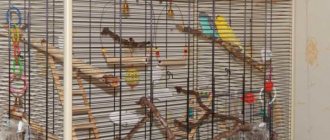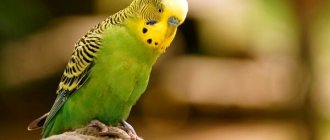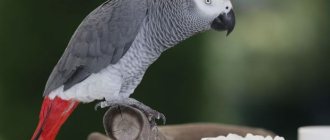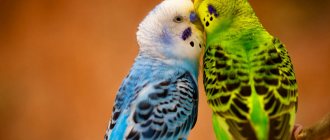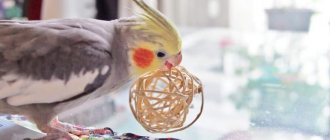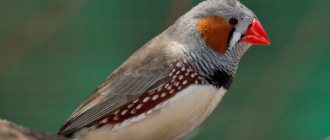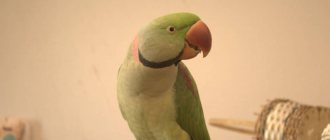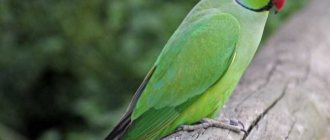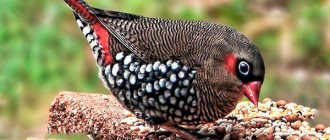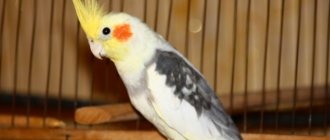Budgerigars are popular pets. This is due to the good tameability of these birds, which are very social by nature.
However, like any pet, a parrot needs care from its owner. Birds are not as demanding as cats or dogs, much less exotic animals that have become popular recently, but caring for them also requires constant attention from the owner. The features of keeping budgies at home will be discussed later in the article.
Choosing an aviary
When you decide to have birds, you should take care of their comfortable stay. After all, birds like space and freedom, and because... the bird will live in a cage, then it needs to be provided with a large and durable aviary. Manufacturers have developed a large number of aviaries for birds. Square, round, metal, wood, twigs.
Size and shape
When choosing a cage, the owner should choose a huge, spacious, strong one, and one that is not dark in it. Pernatics are cowardly birds; to be comfortable, they need a lot of sunlight. By choosing a spacious enclosure for your pet, the owner will provide the pet with maximum freedom. And also if you have other pets, the wavy will not become prey for her.
Good materials from which an aviary can be made are:
- copper;
- tree;
- stainless steel.
Manufacturers often paint the enclosure with a zinc mixture. You shouldn’t buy these, because during peeling your pet can chew it off. This will have a bad effect on his health and lead to poisoning.
The wooden cage is popular among owners. It is harmless and will not cause chemical poisoning to the bird. However, a wooden enclosure should be chosen only from certain trees: willow, maple, birch, linden.
Arrangement
The owner cannot do it simply by purchasing a cage. It must contain the necessary accessories.
Aviary pallet
If the aviary has a grate at the bottom, then it should be removed, because the bird may injure its paws. Fillers are also not needed; you can lay down paper towels, but not newspaper, because the paint on it is toxic.
Perches
It is better to give preference to natural perches with bark. Having 2 or 3 perches is suitable; they should be of different diameters so that the pet’s paws do not get tired. Tree branches will also work.
Feeders
Manufacturers advise purchasing several feeders: for grain, porridge, fruit.
Drinking bowls
There are 2 types of drinking bowls: open and closed. The advantage of a closed drinking bowl is that debris cannot get into it, but this type of drinking bowl is inaccessible to birds. On the contrary, open drinking bowls are good in everything except one thing: garbage constantly gets into them. Therefore, it is worth hanging it in a place that is difficult to reach for garbage.
Sepia/mineral stone
Another necessary thing for a budgerigar is sepia. The bird sharpens its beak on it and receives calcium and minerals. But there is one important point: manufacturers suggest attaching a mineral pebble to a piece of iron, this is not suitable, because... the bird may be injured at the point of the beak. The stone should be tied to a string or attached with a clothespin. An important point: you cannot tie it with a thread, because the bird will clog its goiter.
Toys
To prevent your pet from getting bored, he should hang several toys. Just a little so that the chick can move freely around the cage.
Accommodation
The location of the enclosure depends on the construction of your house. The cage should be placed in a bright place with sunlight, because they are important for the pet's life. You cannot place it on a windowsill near a window. Due to its broad outlook, a bird may see something scary for it in the window, for example, a crow, and get scared. This can lead to stress or death of the bird, because they are very shy.
In winter, there is no need to place the enclosure near the battery. Due to the plumage, as well as the heat from the battery, the bird will be hot. Also, the enclosure should be at eye level of the owner, not on the floor, because walking by all family members will scare the pet. One side of the enclosure is near the wall so that the pet feels safe.
It is advised to choose a neutral room to stay in, where there is no fuss, but only silence.
Temperature
Having taken the bird home, the owner must ensure a comfortable stay, just like in the tropics. The room should be warm and lit. There should be no fluctuations in temperature. Overheating of the wavy can lead to sunstroke, and drafts can lead to illness in your pet. The optimal air temperature in the room is +18-22°C. There is a lot of moisture in the tropical jungle, so for good plumage and shine on the feathers it is worth purchasing a humidifier.
Purity
General cleaning of your pets' cage should be done 1-2 times a month. While the owner is doing this, the parrots can be allowed to fly around the apartment. This way they can stretch their wings and feel a breath of freedom. Before washing the enclosure, you need to remove all the accessories, water bowl, feeder and perches, wash the tray and wipe the bars.
Toys should also be sprayed with a spray bottle until completely dry. If the owner has washed the entire enclosure with detergent or powder, it is worth rinsing it thoroughly with water so that the bird is not poisoned by chemicals.
It is better to clean the tray with an unnecessary toothbrush, because... a metal sponge will scratch the plastic, and in the future dirt will get clogged there.
Breeding
One budgie is still bored, even if people constantly play with him. And if you are rarely at home, then your pet definitely needs a friend. Some owners don't get a second budgie because they don't want to deal with the chicks. But you can have two same-sex birds! If you deliberately get a pair of wavy birds to breed chicks, pay attention to the bird’s wax. This is a small growth above the beak. To put it simply, “nose.” If the wax is brown, this is a female, and if it is blue or light blue, this is a male.
Budgerigars are monogamous. But breeders recommend immediately buying two birds raised in the same flock, so that they definitely do not abandon each other. Although domestic wavy birds rarely behave obstinately towards a new friend or girlfriend, so the risks of being left without bird offspring are small.
Nest house
In captivity, budgerigars reproduce quite actively. But in addition to warmth, light, food and water, one more condition is needed - a house. The female will not allow the male to approach her until she has built a nest in a place hidden from prying eyes. Nesting houses for wavy birds are sold in pet stores and resemble birdhouses: a wooden or plastic box with a hole.
The dimensions of the house must be at least 30*30*30. If it is less spacious, the female may destroy some of the offspring so that the rest of the chicks are comfortable. The bottom of the house is covered with sawdust or hay. You can add medicinal chamomile flowers, which will serve as a preventative against infecting the female and chicks with parasites.
Eggs and chicks
A female budgerigar can lay up to 6 eggs. All this time she will sit in the house and come out only occasionally - to feed. Although some particularly caring males fly into the house and feed the hen. You cannot get the eggs out, otherwise the female may refuse to hatch. You need to check the offspring through the removed top cover of the house. If the eggs sit for more than 3 weeks, they are empty.
A small bird cannot always cope with warming a large number of eggs, so it is necessary to maintain an optimal temperature. If the room is cool, you need to warm the house from outside with a lamp. And no drafts.
A nursing female and grown chicks should be fed with water-based porridges: millet, wheat, barley. When the babies turn 1.5 months old, they will begin to crawl out of the house. As soon as the last chick leaves the nest, the house must be removed. Otherwise, the parents can immediately move on to the next litter. The female needs to gain strength for at least six months.
It is impossible not to love budgies. If these charming birds appear in an apartment one day, then people keep them all the time. Cheerful chirping, perky disposition and friendliness perfectly brighten up loneliness and lift your spirits. You just need to feed the wavy birds correctly and ensure their safety.
Diet
Budgerigars have a varied diet. A balanced complex of nutrients and active substances will help you be completely healthy. Birds should be fed with special food from a pet store, but first the owner can consult with an ornithologist to choose a suitable grain mixture.
In addition to grain, birds should be given vitamins, which they can get from vegetables, fruits, cereals, herbs and nuts. Also, the bird’s body must receive macro and microelements, which should be given separately from complementary foods.
Food and vitamins should be consumed by your pet in certain doses. The grain mixture needs 2 tbsp. per day, as well as water and fruit.
Prohibited Products
Everything that the owner eats will not suit the budgerigar’s diet. You should absolutely not give them caffeine, alcohol or cocoa. This is deadly for the life of the pet. You should also not give baked goods, because the yeast will swell inside the stomach and cause gastrointestinal upset. In addition to these foods, pets should not eat fried, sweet or spicy foods. You can replace all this with a boiled chicken egg, just cook without adding salt.
If the owner decides to pamper the pet with berries or fruits containing a seed, then it must be removed, because... under the influence of moisture, hydrocyanic acid is formed, the consumption of which will also cause food poisoning.
It is also not recommended to give twigs of cherries or cherries, as the bird may choke.
Favorite Products
Budgerigars are not picky eaters, so you can give them what you like. Fruits and vegetables containing vitamins A and B, as well as boiled nuts and cereals. Budgerigars love to crunch, so the owner can safely eat an apple, carrots, cabbage and crackers made from whole grain bran without salt.
Habitat, habitat in the wild
Australia is not only the birthplace of budgerigars (the most common parrots on the mainland), but also their main habitat.
Birds nest along the southwestern and eastern coasts (avoiding northern territories with dense forests), as well as on the nearest islands, including. Tasmania.
When looking for nesting sites, parrots choose steppe and semi-desert areas with sparse trees.
In the north of the continent, breeding of the “wavy” offspring does not depend on the time of year (only the rainy season is excluded), in the south it usually occurs in November-December.
Parrots live in flocks of 20 to several hundred birds. They fly in flocks from place to place, looking for food and water, sometimes stopping in the middle of green plains, where they eat grass seeds.
Birds easily cover vast distances thanks to their high flight speed, similar to the flight of a swallow . When landing, the parrot bends its wings down, like a quail.
Now the number of wild budgerigar populations has decreased significantly. Ornithologists are confident that these are the consequences of human intervention in the Australian landscape.
This is interesting! Aboriginal tribes may also be involved in the process of bird decline, giving the budgerigar the name “bedgerigas,” which translates as “fit for food.”
Communication and training
Many people believe that large parrots, such as Macaws, Jacos, and Cockatoos, are “talking” birds, but this is not true. Wavys are also able to repeat words and insert them where needed, imitating an intelligent bird. It is very easy to teach a parrot to talk using some effective methods.
From birth, being among their own, the chicks imitate older parrots and learn to produce certain sound signals. When they are in captivity, they begin to repeat after those they see and hear, that is, to all family members.
4 essential principles for teaching a parrot to talk:
- Frequent classes. If the owner quickly decided to do this, then it is worth saying the same words regularly and every day. Since this activity is tiring, all family members can record individual words on a voice recorder and play it again.
- Insulation. This method is suitable for those who have not one, but several parrots. Because birds like to chirp among themselves, this can distract them from human speech, so isolate other parrots for a while.
- No anxiety. Before you start training with a bird, you need to understand whether it is alarmed. If everything is fine and she has adapted at home, then you can start.
- Prizes. Any pet can follow the owner's commands for encouragement. If the bird says the word, let it eat the prize. Just don’t overdo it so that your pet doesn’t lose interest in the lessons. Children will also enjoy this activity; they will be willing to watch them.
What do parrots get sick with?
In natural conditions, budgies are extremely rarely susceptible to disease. But when kept at home, birds may experience health problems. Here are some of them:
- Tracheal mite - the main symptoms of this disease: cough, frequent difficulty breathing, anxiety, regurgitation of eaten food.
- Scabies mite - a sign of the presence of this parasite are holes in the area of the cere. The animal is nervous and tries to scratch itself with its beak and paws. You can get rid of this unpleasant disease by treating the parrot with a special compound sold in a pet store.
- Helminths are worms that parasitize the intestines of birds. Infection occurs by eating their eggs in food. The bird is actively losing weight and becoming apathetic. You can see parasites in parrot excrement. It can be cured with the help of a veterinarian.
- Colds - occur in birds due to their exposure to drafts or low temperatures. The parrot sneezes, coughs, and there may be mucous discharge from its beak. The conjunctiva of the eyes often becomes inflamed. This disease must be treated by warming the parrot.
- Gastrointestinal disorders are most often caused by poor-quality food or errors in feeding the pet. Symptoms: the bird is lethargic, apathetic, sitting at the bottom of the cage. The stool is frequent and loose. To restore the functions of the digestive system, you should give the parrot food that is easily digestible and B vitamins.
- Injuries can occur if your pet is handled carelessly. A parrot can injure itself if the floor of the cage is made of twigs. He can also become a victim of other pets (cats, dogs). If your parrot is injured, do not try to adjust anything yourself, but take him to the veterinarian.
- Staphylococcus - infection occurs through contact with a sick animal or through food. The parrot loses his appetite and drinks a lot. Over time, arthritis and cramps may occur. Treatment is carried out with streptomycin or tetracycline, adding it to water or food. To prevent re-infection, you should carefully clean your pet's cage.
By providing your pet with comfortable maintenance and care , you can enjoy his company for a long 12-15 years.
Bathing
Budgerigars come from tropical rainforests and require careful care. There are special fountains where water gurgles, and the birds can bathe and cleanse themselves. You need to bathe the bird once a week. In summer you can 2-3 times a week if it is very hot.
Parrots love water, so if they want to swim, the owner will understand. For shy birds, you can pour water into a saucer and place it next to the cage. Let your pet become interested and take a bath.
If the wings get dirty with paint or other chemicals while flying around the apartment, you should trim them carefully.
Rules for transporting animals
You often have to travel in the company of a pet bird: to the veterinarian, to a foster home, or to the dacha. There are also longer routes when it is necessary to use a train, plane, or car. Air travel and railway travel will cause more trouble, because special documents will be required.
Birds are very sensitive to any change in environment; for them it is always stressful. You can ease the suffering of your budgie while traveling.
Rules for transporting a parrot home
To do this, simply follow certain rules.
- Firstly, only healthy birds are taken on the road. Otherwise, it is better to refuse the trip. Parrots even die when the stress of moving aggravates the disease.
- Secondly, they can only be transported in a special carrier. If you travel far, it should be spacious. Bags, packages, boxes are not allowed! There is a risk of injury.
- Thirdly, there is a danger of catching a cold. Birds cannot be transported in winter! In summer, be sure to provide ventilation in the cage.
Diseases and their prevention
The pet should be in a room where there are no drafts to avoid getting sick. However, there are also depressive illnesses that are more difficult to get rid of. This happens most often in those owners where the chick is alone. This has a bad effect on the bird’s condition, so it becomes aggressive and without communication can literally go crazy. To avoid this, simply communicate with your pet, watch how he lives and plays with toys. This way the bird will feel that it is not alone.
Previous
Vomiting, nausea and belching in a budgerigar
Next
Allergy to parrots
What does a budgie look like?
The budgerigar looks small. The size of a budgerigar is from 17 to 20 cm in length, with a tail length of 8-10 cm and a wing length of about 10 cm. These birds weigh only 40-45 grams. The budgerigar looks very colorful due to its plumage, which is predominantly grass-green in color. The throat and front of the head are a rich yellow color.
Thanks to its long, stepped tail, the budgerigar appears to be larger than it actually is. The curved beak of these birds is covered with a horny layer; it is very mobile and powerful. At the base of the beak there is a cere, on which there are nasal openings. The upper jaw of the beak is much longer than the lower.
The budgerigar's beak is universal. The parrot uses it to pick small branches, leaves, seeds and various fruits. In addition, with its help, budgies can lift and carry various objects. The beak also helps parrots climb tree branches and even defend themselves. The inner side of the beak has teeth that clean the grains from the husks and help to pick and chew the fruits.
Budgerigar chicks have a dark beak; in adult birds it is pale yellow, with a greenish tint. The cere, located above the beak of birds, allows you to determine the sex of a budgerigar. Budgerigars are easily distinguished by the color of the wax. In a young male it is purple, in an adult it is bright blue. In a young female it is blue, in an adult it is blue or brown.
The strong and prehensile feet of this parrot are grayish blue or light pink in color and have black, dark blue or white claws. These birds have 4 sharp and curved toes on each paw. Two of them are directed forward and two are directed backward. This allows parrots to very dexterously climb branches, walk on the ground and grab something with their paws.
One of the unique properties of what a budgerigar looks like is fluorescence (the ability to glow). The feathers of a budgerigar fluoresce when exposed to sunlight. In nature, the presence of fluorescence plays an important role in the reproduction of budgerigars.
Walks in the open air
It is good to take the cage with the birds outside in the summer. Caring for a budgie indoors alternates with walks in the fresh air. It is good to purchase a special harness for walking your feathered pet outside. You can find such a leash for parrots in specialized stores. The harness is worn on birds that trust their owner and have been living in the house for several days.
Benefits for birds from walking in the fresh air:
- health promotion;
- exploration of new territories;
- production of vitamin D from ultraviolet radiation.
On a note! The pet should not be constantly exposed to direct sunlight. He could die from this. The cage must be shaded.
In the evening, the bird house is wrapped in a blanket, leaving one wall free. This way the pet will not freeze and there will be a free flow of air.
Mineral supplements
It is imperative to feed your budgie with mineral supplements. Suitable ones include the following:
- chalk provides calcium replenishment. You can give it in a crushed state or in the form of pebbles. You need to use special chalk, most importantly not construction chalk;
- small eggshell. It has a lot of calcium, magnesium, iron, sulfur;
- bone flour. It contains a lot of phosphorus and calcium;
- The feathered menu needs to be supplemented with special vitamins and minerals, which are sold in the form of complexes in any pet store.
